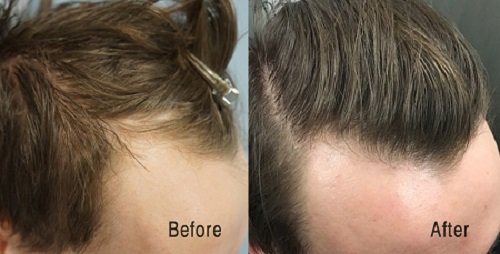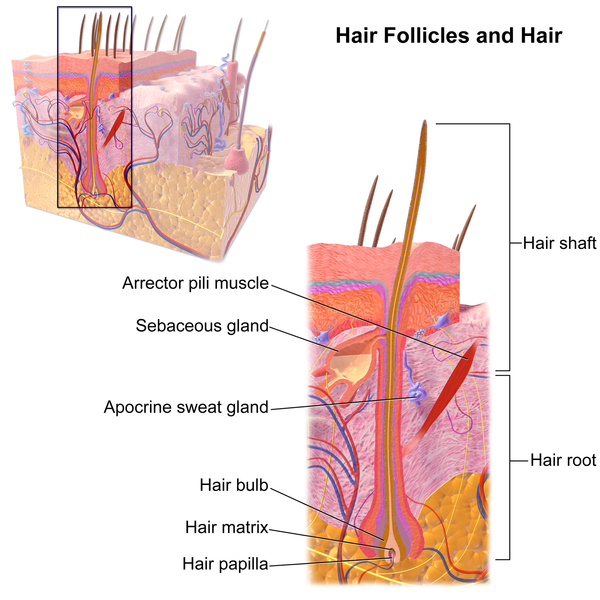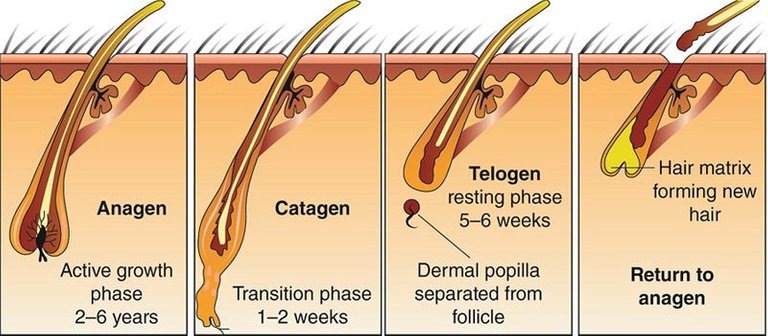For centuries a shining dome has been a symbol of intelligence, or maybe I was told so. But the reality is nobody wants to lose their hair. If you are in your mid-20s and notice a receding hairline, then it might be time to be extra careful. Also, most boys with receding hairlines might have thought of getting some medical treatment or a hair transplant at some point.

Image by Wikipedia under CC BY-SA 4.0 license
If you’ve been thinking about getting a hair transplant, a lot of questions might be running through your head. Is it expensive? are there any side effects? Can I afford the prices they advertise on TV? Does it hurt? How long does it last? One question that probably should have been on your mind before going to the doctor is whether it works or not.
Well, in this article, I will talk about everything you need to know about Hairfall and Hair transplant
First things first, What's Hair made of?
Generally, A person can have somewhere between 100,000 to 150,000 hairs on their scalp. The hair that we see and feel is mostly made of keratin. Now, what's keratin? Well, it's just a leftover protein from the dead cells that are pushed upwards and stacked together as the new cell grows and dies.
 Structure of a hair follicle. Image by Wikipedia under CC BY 3.0 licesne
Structure of a hair follicle. Image by Wikipedia under CC BY 3.0 licesne
The overall structure is very simple though. It all starts in your scalp. From the image you can see, the hair follicle anchors the hair into the skin, but the hair bulb is the one that contains the active growing cells. This is present at the base of each follicle. Each hair bulb is supplied with a good amount of nutrients which of course is very important for the cells to divide and grow.
The cells, that I am talking about that is present in each hair bulb is specialized stem cell which makes keratinocytes. In the scalp, when the hair bulb gets enough nutrients from the blood vessels, the cells divide constantly and make keratinocyte which is pushed upwards. Each keratinocyte is stacked on another making it longer and longer. As it grows, the cell dies and remains as keratin, this is what we see as a visible hair shaft.
I must point out, it's a slow process. Every hair in your body must go through of cycle. The cycle of growing and shedding. This is the cycle I'm talking about:
Anagen Phase: Right now, in a normal individual 90% of the hair is in this phase. The whole growing and pushing upward up keratin thing that I explained above happens in this phase. The hair continues to grow until they are cut. This phase can last somewhere between 3-6 years.
Catagen phase: This phase comes right at the end of the anagen phase. When the blood supply of the hair bulb is cut down, and the active growth of hair stops completely. This is completely normal and can last between 3-4 weeks.
Telogen Phase: The last phase after the catagen phase, when the blood supply is already cut off, hair is in resting phase and ready to shed. In this phase, you might shed approximately 100-150 hair per day. Losing this much is normal, the problem starts when the hair follicle cannot grow hair back after shedding.
 Growth Cycle of one hair. Image by maralhairklinik under creative commons licesne
Growth Cycle of one hair. Image by maralhairklinik under creative commons licesneOk, But why do some go bald? What really happens in the scalp?
Well, there can be various reasons for a single individual, but if you ask me, I will always blame two things. One is Genetics and the other your Hormones.
In males, the hair loss genes are mostly inherited from the parents. When those genes have been expressed the follicles in the scalp can become very sensitive to a hormone called "Dihydrotestosterone" or "DHT" which is made from "testosterone".
This is the reason, why most males experience "male pattern baldness". But, the expression of those genes can depend on many factors like the environment or a stressful life. these things can trigger the genes to express earlier.
I always recommend having a good hair massage day every week, because a bad blood supply in your scalp can increase the chances of hair loss faster.
if you are losing hair, then you might have considered a hair transplant at some point.
What really is a Hair Transplant?
Well, The concept of hair transplant is fairly old, all the way back to the 1950s, when doctors first realized, a hair follicle can be taken from one part of the body and transplanted to another part. In those days, doctors would try to take small patches from the back of the scalp and transplant them in the needed areas. But this technique was not ideal as it created patches of hair which for sure looked horrible.
Thanks to our great doctors, medical science has progressed quite a lot now in the field of hair transplantation. Imagine picking up hair one by one and transplanting them.
You might be thinking, where do you get the hair from? who's the donor?
Well, my friend in most of the cases, the person is the donor himself. You see, in male pattern baldness, the hairs in the back of the head are mostly spared. This region serves as a donor region mostly. Hair from any part of the body can be used but it won't be ideal. Imagine making your chest hair as a donor region, would it be an ideal one?
Now, there are mostly two main types of hair transplants in the market. They differ in the process of how the hair is extracted from the donor region but give you the same result. Don't get me wrong, even though both techniques give you the same result, they have their pros and cons.
- Follicular Unit Transplant or FUT
- Follicular Unit Extraction or FUE
What's the FUT method of hair transplant?
It's really simple to understand, but it's not an easy procedure. A very experienced surgeon cuts a strip of skin from the backside of the scalp or head. The size of the strip depends on how much hair is needed. That strip can contain more than 1000 hair follicles.
A team extracts each follicle from the strip of skin and makes it ready to transplant on the scalp. This can take somewhere between 5-8 hours depending on the volume of the hair follicle, and it's done under local anesthesia so, most patients stay awake during the procedure. Cool right?
Here's what it will really look like to the person
A surgeon will take photographs of your scalp and mark the area with a marker where hair will be transplanted.
An assistant will inject local anesthesia into your scalp.
The hair from the donor region will be trimmed, to make the hair extraction easier.
Surgeon will jump in and cut off the strip of skin which will of course contain a lot of hair follicles.
A team helps to extract each hair follicle from the strip and turn them into grafts.
surgeon will apply the suture to close the cut wound.
Finally, the hair grafts are inserted in the marked areas.
After the surgery, you will have to wait at least 4-5 months with regular follow-ups for the results to appear.
Now, this is one way of doing it, let's talk about another one, and I will tell you the pros and cons of both surgeries.
Now, What's the FUE method of hair transplant?
This is a newer method and a bit different from FUT. A surgeon takes out an individual hair follicle at a time from the backside of the head. The difference is, here a strip of skin is not taken out, rather random hair follicles are chosen and taken out.
After this, the process is the same as FUT surgery.

Follicular unit extraction method. Image by Wikipedia under CC BY-SA 4.0 license
Which one's the best? Let's talk about Pros and Cons
If you ask me, Nowadays, the FUE method is more popular than FUT. Well, even though it is popular, both have advantages and disadvantages. Let's look at them now.
Pros of FUT Method:
When a strip of skin is taken out, it contains a considerably large amount of hair follicles. Which is an advantage if an individual needs more amount of grafting.
Not all hair is needed to be shaved while performing the surgery.
The surgery time is shorter.
It can be cost-effective depending on where you live.
Cons of FUT Method
A big Scar is left out on the backside which is not very pleasant to look at.
Recovery period is longer, as you have come back for regular follow-ups and the suture area needs care.
Chances of infections are high with bad care.
Pros of FUE Method
After recovery, the head is scar-free, which most patients prefer.
It is suitable if you don't need a large volume of hair.
The recovery period is shorter, about 1-2 weeks.
Cons of FUE Method
- It is very expensive.
- It's very time-consuming. Extracting individual hair follicles needs time. This procedure is done in sessions, Each session can be 4-8 hours long.
- Also, it has been found that, in bad storage conditions, 40% of grafts may already die before transplant even starts, making it ineffective. Consider this while getting a hair transplant.
What's the actual cost of all this?
In a global scenario, the price differs, from country to country, state to state, continent to continent. There is no fixed price to this.
Similarly, the cost of FUE can be twice as much as the FUT procedure. As FUE needs more medical staff to conduct the surgery.
In the USA each session can cost you about $5000 to $15000 which is quite expensive. Here is an average price list from different countries between 2020 and 2021
Canada - an average of $17500
Australia - $13750
USA- $13600
UK- $8050
Germany- $7500
India -$3500
Nepal - $3000
Turkey - $2500
This is an average price. And the cost depends on the number of grafts required, the number of medical staff, and the surgeon. For example in India, Nepal, and Turkey, Each graft costS from $0.2 to $1. Which is quite cost-effective.
Is It safe? Are There Any Side Effects?
Yes, it is safe. No side effects have been observed till now. But yeah it's a surgical procedure. And every surgical procedure can have some complications. Most common being
- Bleeding
- Infections
- Swelling in the scalp
- Numbness in the transplanted area
- Patches of unnatural-looking hair.
- Shock Loss is temporary hair thinning after the surgery.
- AND most intense urge of itching right after surgery.
Most of the patients said the urge of itching in the healing and recovery process is quite intense. But this can be easily controlled with proper medication and gentle scalp wash with the doctor's advice. Some patients also complained of eye bruising.
The Bottom Line
If you are in your mid-20s and 30s and have been noticing a visible thinning of hair, you can consider this and talk to your doctor. A good amount of cash is required though if you live in an expensive country. The procedure is safe if performed by a good medical team.
You will still lose some hair but the results can be permanent if you follow every piece of advice by your doctor and give it good care.
If any doubts feel free to ask me below in the comment section
That's it for this article guys. See you in the next one.
Previous Article:
Refrences:
- https://ishrs.org/2014/09/10/fue-what-is-it/
- https://www.webmd.com/skin-problems-and-treatments/hair-loss/hair-transplants
- https://www.scalpny.com/blog/fue-vs-fut/
- https://www.statista.com/statistics/1233463/hair-transplant-total-cost-selected-countries/
- https://en.wikipedia.org/wiki/Hair_transplantation
- https://www.thepmfajournal.com/features/post/a-guide-to-hair-transplantation
- https://www.practo.com/health-wiki/hair-transplant-india/276/article
Very educative content on hair transplant. This is my first time reading something scientific on the subject since I first heard about it when Wayne Rooney, a famous footballer back then, underwent a hair transplant.
Do the transplanted hair continue growing naturally and follow the normal hair cycle or they are permanently stationed in the transplanted regions by exiting the cycle?
thanks, gentlehshaid.
Actually, the transplanted hair grows normally and yes it follows the natural hair cycle because hair follicles are transplanted, which have the ability to grow. But, results can take time, for the full growth of transplanted hair, it can take up to 6-9 months.
As always . it was a nice read.. doc
is less expensive hair trasplant as effective as the expensive ones?
Thanks, curiousity :)
Actually, it depends, on the quality of the medical team and the experience of the surgeon but, surely, it is cheaper in the Asian countries because their health facilities are cheaper in general.
Nice to have you back
thanks, bhoa :)
I actually think it make me feel more manly like Jason statham
Thanks for your contribution to the STEMsocial community. Feel free to join us on discord to get to know the rest of us!
Please consider supporting our funding proposal, approving our witness (@stem.witness) or delegating to the @stemsocial account (for some ROI).
Please consider using the STEMsocial app app and including @stemsocial as a beneficiary to get a stronger support.